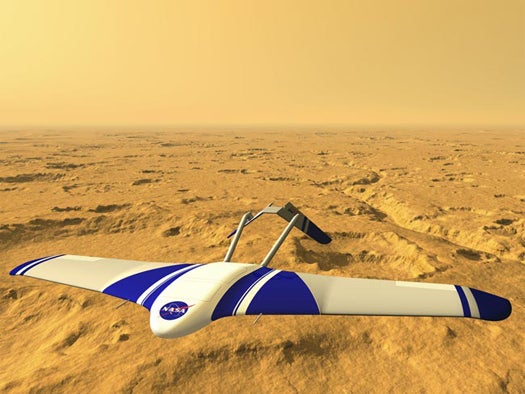NASA Moves Ahead With Robotic Plane to Take Mars Exploration to the Skies
As a general rule, when NASA flies a scientific mission all the way to Mars, we expect that mission to...

As a general rule, when NASA flies a scientific mission all the way to Mars, we expect that mission to last for a while. For instance, the Spirit and Opportunity rovers were slated to run for three months and are still operating 6 years later. But one NASA engineer wants to send a mission all the way to the Red Planet that would last just two hours once deployed: a rocket-powered, robotic airplane that screams over the Martian landscape at more than 450 miles per hour.
ARES (Aerial Regional-Scale Environmental Surveyor) has been on the back burner for a while now, and while it’s not the first Mars plane dreamed up by NASA it is the first one that very well might see some flight time over the Martian frontier. Flying at about a mile above the surface, it would sample the environment over a large swath of area and collect measurements over rough, mountainous parts of the Martian landscape that are inaccessible by ground-based rovers and also hard to observe from orbiters.
The Mars plane would most likely make its flight over the southern hemisphere, where regions of high magnetism in the crust and mountainous terrain have presented scientists with a lot of mystery and not much data. Enveloped in an aeroshell similar to the ones that deployed the rovers, ARES would detach from a carrier craft about 12 hours from the Martian surface. At about 20 miles up, the aeroshell would open, ARES would extend its folded wings and tail, and the rockets would fire. It sounds somewhat complicated, but compared with actually landing package full of sensitive scientific instruments on the surface deploying ARES is relatively simple.
The flight would only last for two hours, but during that short time ARES would cover more than 932 miles of previously unexplored territory, taking atmospheric measurements, looking for signs of water, collecting chemical sensing data, and studying crustal magnetism. Understanding the magnetic field in this region will tell researchers whether the magnetic fields there might shield the region of high-energy solar winds, which in turn has huge implications for future manned missions there.
The NASA team already has a half-scale prototype of ARES that has successfully performed deployment drills and wind tunnel tests that prove it will fly through the Martian atmosphere. The team is now preparing the tech for the next NASA Mars mission solicitation and expects to see it tearing through Martian skies by the end of the decade.